How to Quickly Find Featured Snippet Opportunities For Your Site
Capturing a featured snippet opportunity is a great way to improve your visibility on the first page of Google SERPs. That helps you to significantly improve web traffic from searches for your keywords.
You can find and seize featured snippet opportunities without creating new content. You don’t even need to search out new backlinks. Interested? You should be.
Book a Consultation
Featured snippets can be like gold dust for your SEO. We’re going to give you all the information you need to quickly find the opportunities you might be missing. First, though, let’s get you up to speed with what featured snippets are. We give an example in the featured image of one we have done which is for the following article on how much does SEO cost.
What is a Featured Snippet?
Featured snippets are partial answers to a specific user query in Google. They’re shown at the top of Google SERPs. For that reason, they’re often also referred to as ‘position zero’ or ‘rank 0’. That’s because they’re displayed to searchers above position one on the SERP.
Google themselves have provided a handy explanation of how featured snippets are generated:
‘When we recognize that a query asks a question, we programmatically detect pages that answer the user’s question, and display a top result as a featured snippet in the search results.’
Featured snippets are not the same as knowledge panels or ‘People Also Ask’ widgets. The main difference is that they include a link to the pages they’re drawn from. They’re also often displayed alongside an image which links to a different page.
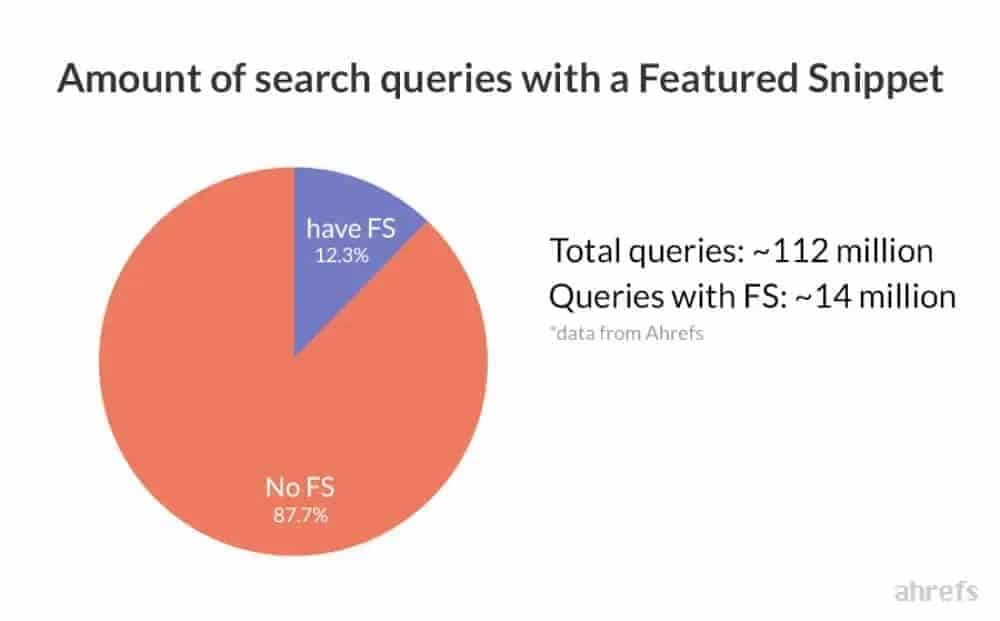
Not all SERPs have a featured snippet. An Ahrefs study looked at around 112 million keywords. It found that close to 14 million had featured snippets on their SERPs. That’s about 12.3% of the SERPS. There are likely, then, to be plenty of featured snippet opportunities out there for you to seize upon.
That same study also revealed something interesting about where featured snippets come from. In almost all cases, the snippets are drawn from pages ranking in the top ten for the search query in question. Only around 30% of the time do they come from the number one ranking page. More on that later.
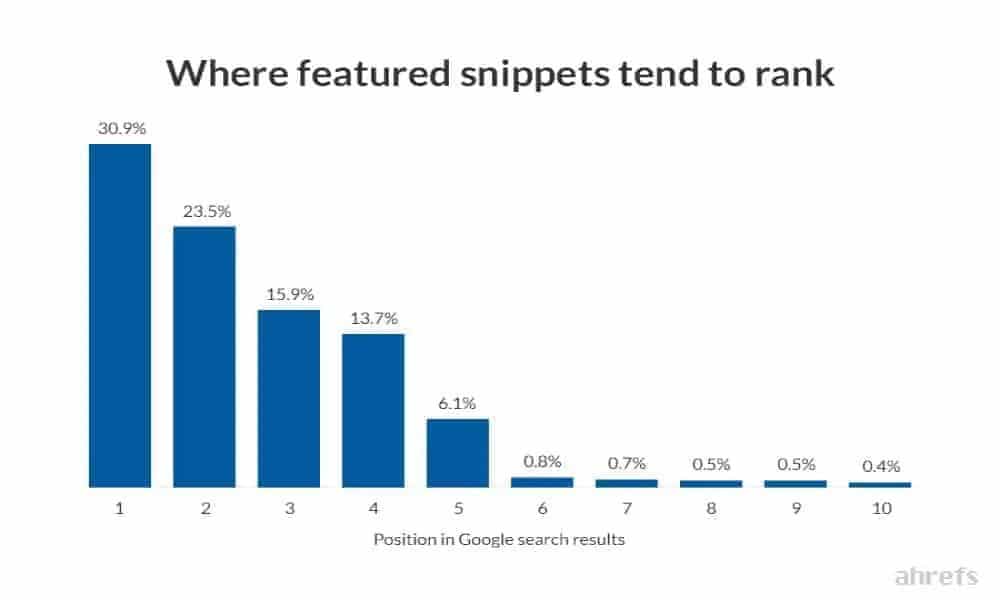
Types of Featured Snippet
Featured snippets don’t all take the same format. They fall into the following three main categories:
- Paragraph Snippets
- List Snippets
- Table Snippets
Paragraph snippets are the most common. Data compiled by STAT Search Analytics found that around 82% of featured snippets fall into this category. They’re short passages of text offering a succinct answer to a query.
10.8% of featured snippets are list snippets. These can be either numbered or bullet pointed lists. Numbered list snippets tend to be displayed when a query suggests that step-by-step instructions are needed. Bulleted snippets are generally when Google format the headings of a list post into bullet points.
Table snippets are the least common. Only around 7.3% of featured snippets come into this category. They’re displayed to show off structured data or data where direct comparisons are needed. Google don’t extract existing tables from content. They re-format data into the table snippet.
All these categories can provide featured snippet opportunities for your site. What, though, makes those opportunities worth your while?
Why Should You Care About Featured Snippet Opportunities?
If you’re at all involved with SEO, you’ll know what a bunfight it can be. Trying to get the top rankings on SERPs for your keywords is no easy task. It can take a huge amount of time, effort and expense to move your pages up those rankings. For all but the largest organisations, position one is little more than a pipedream for most keywords.
Featured snippets take up exactly the real estate you’ve been fighting for. They appear at the very top of the SERP. Above the page that has done all those hard yards to rank first. That might seem a little unfair. Who cares, however, as long as it’s you who’s grabbed the featured snippet for yourself?
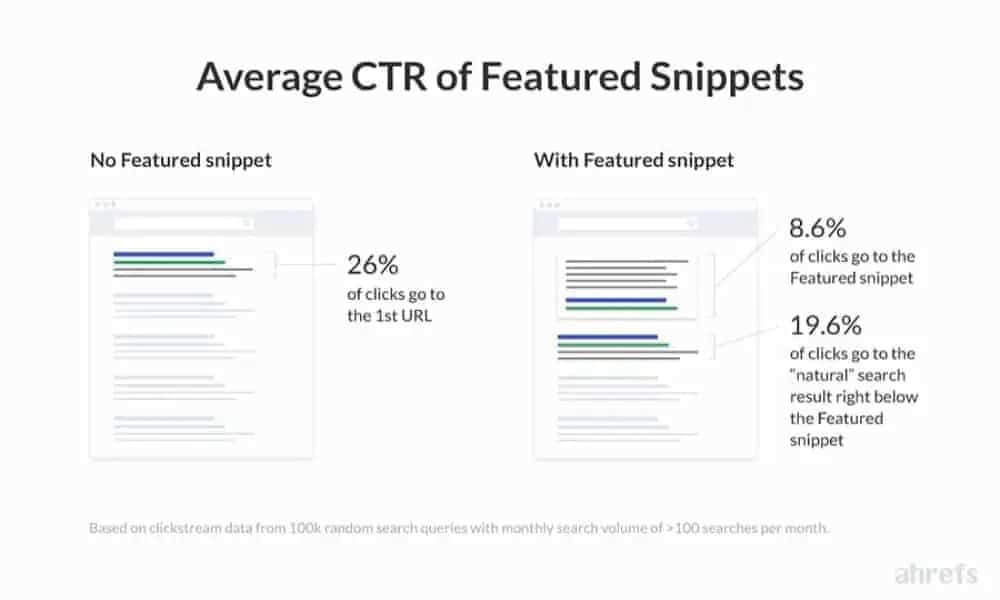
Given their prized position at the top of the SERP, featured snippets have a predictable effect on traffic. Ahrefs found that some 8.6% of clicks go to the featured snippet when there is one. Those clicks are drawn from all the other results, including the number one ranked page.
That makes featured snippet opportunities worth seizing in two different situations:
- When You’re Ranked Number One – If your page is number one, you don’t want someone else’s featured snippet leaching your traffic. You want to have the snippet as well. That way you get an even higher percentage of web traffic from the search query.
- When You’re Ranked Between Number Two & Number Ten – Featured snippets can be drawn from any page ranking in the top ten of a SERP. Only around 30% of snippets actually come from top ranking pages. Grabbing a featured snippet opportunity is a great way to essentially leap-frog pages ranked above you. As the above graphic shows, it can get you anywhere up to around 8.6% more clicks from the SERP.
The benefit delivered by grabbing featured snippets should be plain to see. Just as notably, it’s also quite easy to take advantage of featured snippet opportunities. One single page can own hundreds or even thousands of featured snippets for different queries.
That means that one bit of quality content can deliver a boost in traffic from loads of SERPs. That’s quite a contrast to the slog involved in ranking pages for all those different keywords. With that in mind, you’ll doubtless want to know how you can find featured snippet opportunities for your site.
How to Find Featured Snippet Opportunities
Good solid research is the key to finding featured snippet opportunities for any site. There are three main types of research you’ll need to do:
- Research into where your own site already stands as regards featured snippets
- Keyword research to find quick-win featured snippet opportunities
- Question-focussed keyword research to identify other opportunities
Seeing Where You Stand
Before you can start identifying new opportunities, you need to know where you stand. That means working out how your current content is doing as regards featured snippets. It’s quite easy to do this by using one of the following, popular paid SEO tools:
Each of those tools give you access to in-depth analytics of your site. That includes being able to find out which of your pages have already produced featured snippets. You’ll want to take note of how many you do already have.
You’ll also want to take a look at what the pages producing snippets have in common. Is there a particular style or format they all share? If so, this gives you your first clue as to what to do to get more featured snippets. We’ll talk more about that later.
If you find you don’t currently have many featured snippets, it’s not the end of the world. The next stage of your research is what’s going to give you loads of featured snippet opportunities for your site.
Finding The Easiest Featured Snippet Opportunities
The SEO tools we mentioned earlier make it easy to find some quick-win featured snippet opportunities. What we mean by that are opportunities that you can seize swiftly and easily with very little effort.
To find those opportunities, simply head to your chosen tool and analyse your own site. What you’re looking for are SERPs with a featured snippet that you rank in the top ten for. You can obviously disregard any where the featured snippet is already yours.
The featured snippets on these SERPs are there for the taking. You know that Google already like your page. It wouldn’t be on page one if they didn’t. All you need to do is to look at the page that currently owns the snippet and work out why.
Then you can go about editing your page so that it betters it. Exactly what you may need to do will vary from SERP to SERP. The following are some possible suggestions:
- List Post Formatting – If the featured snippet is a bulleted list, you might want to check on your content’s formatting. Google tend to compress the H2 tags from list posts to create bullet list snippets. Make sure the search engine can understand the format of your page.
- Step-By-Step Lists – Numbered list snippets generally offer step-by-step instructions to answer a query. To get these snippets your content will need to include something similar. A good idea is to put a step-by-step summary of the process your page explains towards the top.
- Strong Openings – Paragraph snippets provide succinct answers to users’ queries. The best way to get these snippets is to have an equally succinct answer in your content’s introduction. The strength of this tactic is shown by Wikipedia. Their pages all have a short summary paragraph at the start. In the USA, Wikipedia also own over 11% of all featured snippets according to Ahrefs.
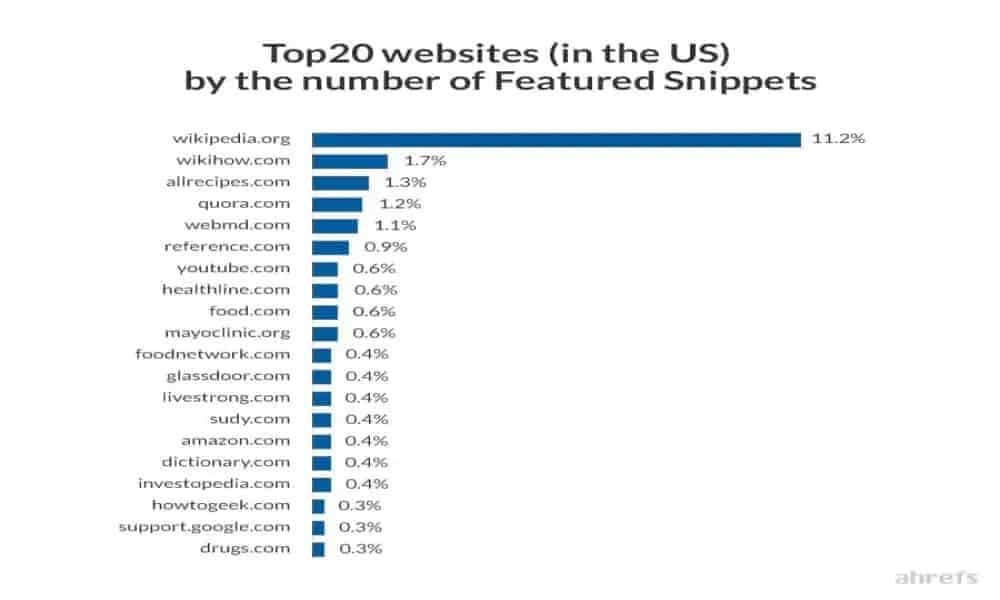
Finding Other Featured Snippet Opportunities
You should now know how to find the featured snippet opportunities for keywords you already rank for. Those are far from the only opportunities out there. Finding those other opportunities is just as easy as following the steps we’ve already discussed. In fact, it’s just like general keyword research but with a bit more of a focus on questions.
First of all, you’ll want to head back to your trusty SEO tool. Once there, you need simply pop a seed keyword into its keyword checker area. That will then display related keywords. By tweaking the tool’s settings you’ll be able to get it to display only those which have a featured snippet on their SERP.
That gives you a new list of keywords to potentially target with featured snippets in mind. You can also make use of the URLs of those sites that currently own the snippets. Popping them into your SEO tool can help you generate a list of other keywords that they own snippets for. There’s another list of featured snippet opportunities for your site.
This research doesn’t have to rely solely on paid SEO tools. AnswerThePublic is a free service that can also be really useful. All you have to do is enter a keyword. The site will then provide any and all possible questions involving that keyword. The following is an example of the result you get when inputting ‘featured snippets’:

These questions are to all intents and purposes long tail keywords. When used as search terms they will often have featured snippets on their SERPs. With just a little further research and optimisation you can grab those featured snippet opportunities for your site.
Tips For Capitalising on Featured Snippet Opportunities
You now know all about featured snippets and why they matter. You’re up to date on the best ways to find featured snippet opportunities for your site. We’ve also touched a little on how to seize upon those opportunities. Let’s wrap up by taking some time to expand on that. The following are hints and tips that should help you grab all the featured snippets you could want.
Content Tips
Designing content to get featured snippets is all about questions. It’s keywords including questioning words like ‘how’, ‘what’ and ‘why’ that most often generate the snippets.
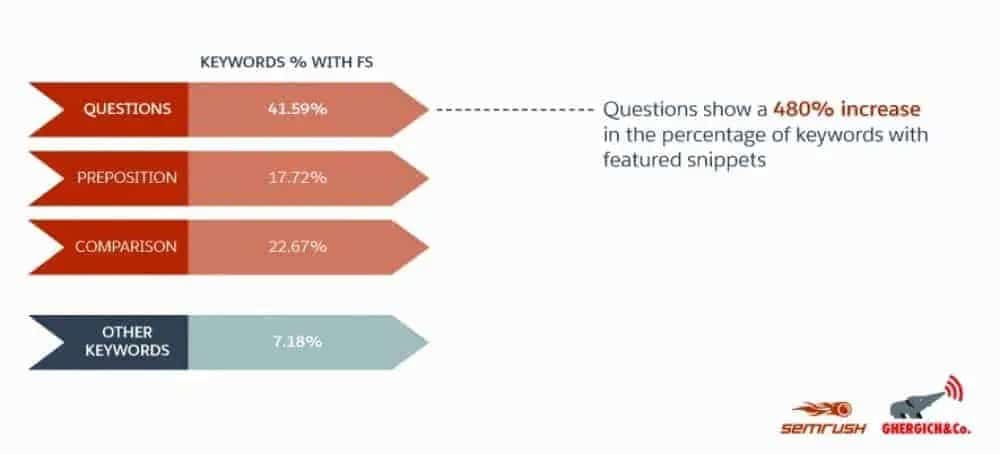
That’s great news when it comes to your content. Those types of keywords are most likely to be of the long tail variety. Content based on long tail keywords is great for answering user intent as well as earning snippets. Focussing on those keywords is a win-win.
What you need to ensure is that your content does answer the question you’re targeting as a keyword. That may seem obvious, but you’d be surprised at the number of posts and articles that don’t do this. To get a featured snippet, Google need to be able to find a succinct answer to the question within your content.
If you’re tilting at a paragraph snippet, you’ll want to provide that succinct answer yourself. Try to weave it into your introduction and Google may just lift it for the snippet. You will also want to show that your full content has more to offer. A featured snippet is no good to you if it doesn’t also persuade a searcher to click through to your page.
Formatting Tips
In many ways, formatting is key to seizing featured snippet opportunities. There are a handful of things to keep in mind when it comes to formatting for snippets.
It’s helpful to start list posts or step-by-step guides with summaries of the content as a whole. A bulleted or numbered list of the steps the page is going to take a reader through is a great option. In many cases those summary lists are lifted by Google for their list snippets.
Speaking of list snippets. To get those, it’s vital to use HTML heading tags properly in your content. They make the content much easier for Google to read. The search engine also often condense a page’s H2 tags to created bulleted list snippets.
Where it’s natural to do so, you’ll also want to include tabular or structured formatting. Using tables or rows and columns makes it easier to compare information. It also gives Google a potential push towards giving your page a table snippet.


